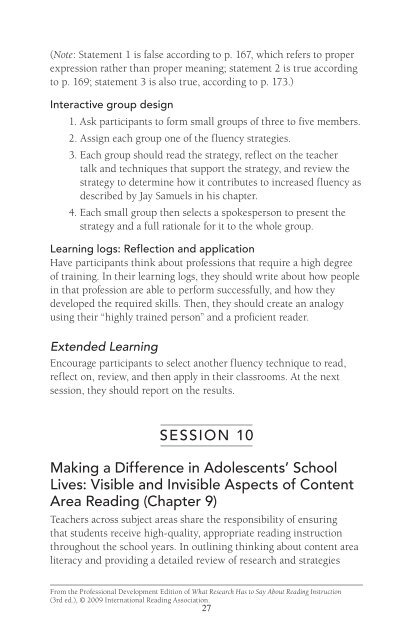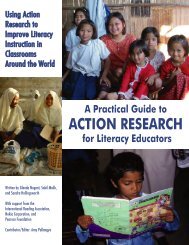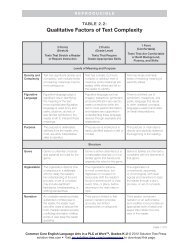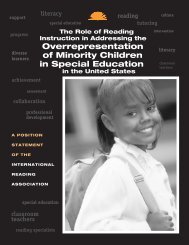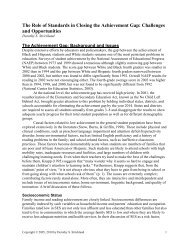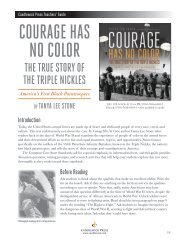What Research Has to Say About Reading Instruction - International ...
What Research Has to Say About Reading Instruction - International ...
What Research Has to Say About Reading Instruction - International ...
You also want an ePaper? Increase the reach of your titles
YUMPU automatically turns print PDFs into web optimized ePapers that Google loves.
(Note: Statement 1 is false according <strong>to</strong> p. 167, which refers <strong>to</strong> proper<br />
expression rather than proper meaning; statement 2 is true according<br />
<strong>to</strong> p. 169; statement 3 is also true, according <strong>to</strong> p. 173.)<br />
Interactive group design<br />
1. Ask participants <strong>to</strong> form small groups of three <strong>to</strong> five members.<br />
2. Assign each group one of the fluency strategies.<br />
3. Each group should read the strategy, reflect on the teacher<br />
talk and techniques that support the strategy, and review the<br />
strategy <strong>to</strong> determine how it contributes <strong>to</strong> increased fluency as<br />
described by Jay Samuels in his chapter.<br />
4. Each small group then selects a spokesperson <strong>to</strong> present the<br />
strategy and a full rationale for it <strong>to</strong> the whole group.<br />
Learning logs: Reflection and application<br />
Have participants think about professions that require a high degree<br />
of training. In their learning logs, they should write about how people<br />
in that profession are able <strong>to</strong> perform successfully, and how they<br />
developed the required skills. Then, they should create an analogy<br />
using their “highly trained person” and a proficient reader.<br />
Extended Learning<br />
Encourage participants <strong>to</strong> select another fluency technique <strong>to</strong> read,<br />
reflect on, review, and then apply in their classrooms. At the next<br />
session, they should report on the results.<br />
SESSION 10<br />
Making a Difference in Adolescents’ School<br />
Lives: Visible and Invisible Aspects of Content<br />
Area <strong>Reading</strong> (Chapter 9)<br />
Teachers across subject areas share the responsibility of ensuring<br />
that students receive high-quality, appropriate reading instruction<br />
throughout the school years. In outlining thinking about content area<br />
literacy and providing a detailed review of research and strategies<br />
From the Professional Development Edition of <strong>What</strong> <strong>Research</strong> <strong>Has</strong> <strong>to</strong> <strong>Say</strong> <strong>About</strong> <strong>Reading</strong> <strong>Instruction</strong><br />
(3rd ed.), © 2009 <strong>International</strong> <strong>Reading</strong> Association.<br />
27


